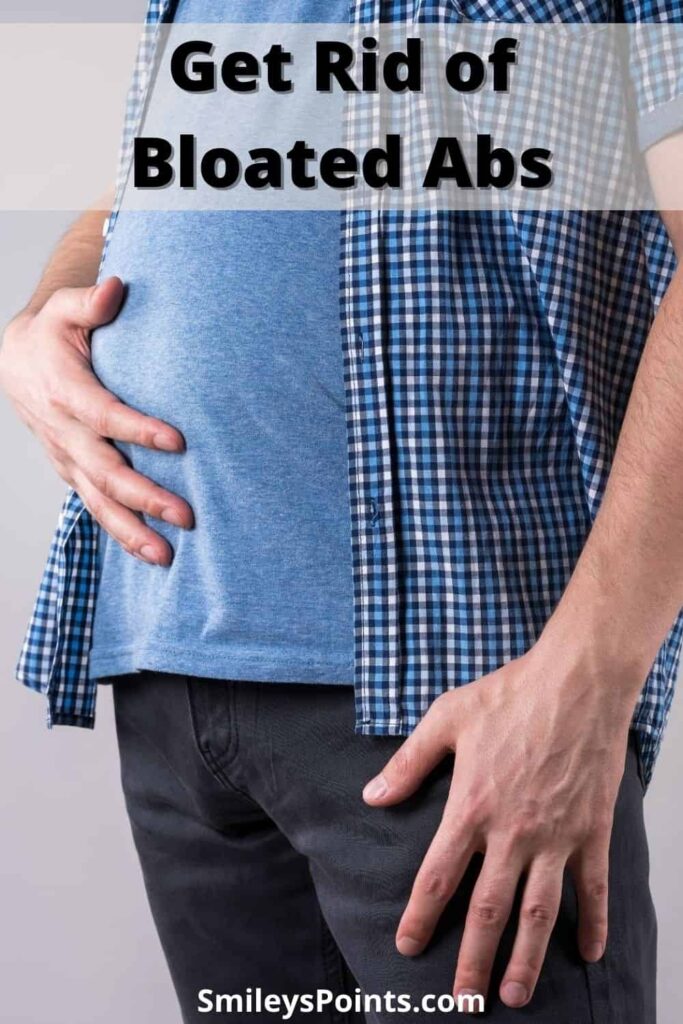
In determining how to get rid of bloated abs, you must first discover the cause. It is normal for a stomach to bloat after consuming a large meal, drinking carbonated beverages with or without artificial sweeteners, or gas, but this does not mean you have bloated abs. Here are some ways to determine whether the cause is stomach bloat or bulging abs as the causes are vastly different.
Stomach Bloat as a Gastrointestinal Problem

A build-up of gas induced by certain foods and beverages can cause a bloated stomach, and if you eat too quickly, you can swallow air, causing flatulence as well. The excess gas build-up creates abdominal distention.
A distended stomach may be triggered by sensory responses, certain foods, or underlying gastrointestinal disorders, like celiac disease or irritable bowel syndrome.
Stomach Bloat as a Bulging Abs Issue
The most common reasons are injuries sustained while working out and pregnancy, but the causes vary drastically. You need to determine the causes before you can begin to get rid of bloated abs.
Poor Lifting Methods
Exercise can cause muscles to bulge. When we lift heavy loads without adequate abdominal bracing, we can cause bulging abdomens. It is not a single act that causes it, but a series of poor lifting methods. Additionally, large amounts of weight gain stretch the muscles and the linea alba, creating this issue.
Pregnancy
Tears in the diastasis recti may occur during a pregnancy. As the baby grows, the abdomen extends to support the baby. While most women don’t notice the tears because they happen slowly, you may feel abdominal pain or pressure, like your stomach is being overly stretched.
You can resolve this issue by wearing a pregnancy belt to support the spine and back and encourage good posture. It also alleviates many discomforts associated with pregnancy.
How Can I Get Rid of Bloated Abs?
To eliminate bloated abs safely, experts recommend engaging the abdominal muscles with pelvic floor, abdominal wall, and isometric exercises, stabilizing and strengthening your core.
- Kegel Exercises. You can do Kegels while seated on an exercise ball or chair, lying down, or standing. To do them properly, hold and engage the deep pelvic floor muscles. It requires practice, and you will need to do a lot of reps.
First, locate the pelvic floor muscles. The best way to do it is to stop urinating midstream. Then contract the muscles by holding them for one to two seconds. Do 10-20 repetitions and repeat two to three times daily.
2. Planks or Isometric Exercises. These exercises are a great way to keep the abs together. To do them, get into a plank position, supporting yourself with your elbows and toes. If this is too strenuous, you can also do this exercise on your knees. Be sure to keep the body in a straight line.
Begin by engaging transverse abdominal muscles and your obliques by pulling the rib cage down and pulling up the pelvis. Do two to three repetitions, hold the pose for 15 seconds, then repeat it one to three times daily.
3. The Dead Bug. Start by laying on your back. Pull the knees up to the chest and bend the knees to a 90° angle. Reach the hands to the air and engage the core by placing the ribs down and the pelvis up. Push your back to the floor, but refrain from arching your back.
Place one arm down facing the ground. Reach above the head as the opposite leg is lowered. Alternate sides to maintain the stability of the core muscles. Do two sets six to ten times.
Common Mistakes to Avoid that Cause Bloating
There are some common mistakes about abdominal bloating that you should avoid. They are:
- Refrain from eating large, high-carb meals. The macronutrients found in these dishes are difficult for the body to metabolize. They are harder to digest and create gas in your digestive system. Instead, choose to eat low-carb meals.
- While exercising, watch your posture. The easiest way to sustain an injury is poor posture. Poor posture allows the ab muscles to stretch. Slouching is not uncommon and is likely to create a muscle strain by using improper form, which can cause bulging.
- Breathe deeply while exercising. Breathing correctly benefits individuals by permitting oxygen to enter the spinal cord, keeping blood-rich oxygen flowing, and expanding your diaphragm, expelling gas. With less gas comes less bloat.
- Don’t overtrain the muscles. Many people think intense ab exercises are beneficial, but they can lead to injury. Overtraining leads to a breakdown beyond what is repairable by using muscle protein synthesis. The muscles end up becoming weaker and prone to tears. In this state, they are susceptible to bloating and swelling.
- Watch what you eat and isolate the cause. Watching what you eat and isolating the cause go hand in hand because they can be isolated incidents or intertwined. Caffeinated beverages, carbonated beverages, sweets, and certain foods will cause stomach bloat. Food allergies will also have the same effect, especially if you have lactose intolerance, celiac disease, ulcerative colitis, or irritable bowel syndrome.
Sometimes it isn’t the type of food as much as isolating what is causing our stomach to bloat in the first place. You could have an unknown allergy or other gastrointestinal disorders.
These are a few common things to avoid when looking to decrease abdominal bloating. Most of them are obvious.
To further help you in your journey, programs like Healthi/iTrackbites and Noom can teach you what foods to avoid and what to eat to decrease that uncomfortable bloated feeling. They also allow you to track what you eat, so if the cause is food-related, you can isolate the days and what you consumed to better track the possible cause of stomach bloating.
Getting rid of bloated abs can be done by isolating the cause. Is it food-related or due to exercise? When we isolate the cause, the solution becomes easy.
